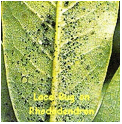Lace bugs have piercing-sucking mouthparts and are named because of the flat lacelike wings of the adults. They are members of the Tingidea family and are insect pests. Lace bugs should not be confused with the beneficial lacewing insects that have long wings held vertically against their sides. Lace bugs that are found in the genus Stephanitis attack broad-leaved evergreens (andromeda, rhododendron, azalea, and mountain laurel) and can cause significant feeding damage. These insect pests overwinter as eggs that are inserted into plant leaves. A second group of lace bugs belonging to the genus Corythuca have a wide host range that includes oak, sycamore, hickory, hawthorn, walnut, and cherry. Each lace bug species is named for its principal host plant. The life cycles and control for lace bugs are all similar with the exception that lace bugs feeding on deciduous plants (plants that shed their leaves in the fall) overwinter as adults in the leaf litter. The following description is of the andromeda lace bug, Stephanitis takeyai, the most common species encountered in this area.

The andromeda lace bug is believed to have been accidentally introduced into the United States from Japan in 1945. It is a serious pest of Japanese andromeda, Pieris japonica.
Life Cycle
The andromeda lace bug overwinters as an egg on the undersides of the lower leaves of the plant. The eggs begin hatching in early to mid-May. The small (1/16-inch) black spiny nymphs (immature insects) begin to feed immediately. After one or two molts (growing stages), they scatter to other leaves. It takes approximately one month for the nymphs to become adults. The 3/16-inch adults have net-veined clear wings with black markings and a somewhat rectangular shape. Adults lay eggs along the midrib on the underside of the leaves. Andromeda lace bugs can have four or five generations per year in Connecticut.
Injury
Lace bugs feed by sucking juice from plant leaves, extracting the protein they need and excreting liquid waste as honeydew. The most common symptom of feeding is the stippled and mottled yellowish foliage. Positive signs of lace bugs are the insects, whitish cast-off skins and/or dark brown tarlike excrement on the underside of the leaves. In heavy infestations, black sooty mold, a nonparasitic fungus, may develop on the honeydew. If leaves become covered with sooty mold, photosynthesis production is reduced, thereby reducing the production of carbohydrates needed by the plant. Damage is most severe on plants in full sun. Heavily damaged leaves that become blanched and yellowish-grey may drop from the plant. This often results in some dieback of twigs and branches and a reduction in flowering the following spring.
Control
To control lace bugs, thoroughly spray the undersides of the leaves as soon as nymphs appear in mid-May. Horticultural oil or insecticidal soap can be used for control of lace bugs. Please contact your local Cooperative Extension Center for additional chemical and other management options or visit the on-line guides of Cornell University and Penn State. Note: This information may not apply to your state or other geographical area.
Updated by Donna Ellis, Senior Extension Educator, UConn IPM Program, 2011.
By Milton G. Savos, Extension Entomologist. Updated in 1995 by Marie L. Dube, Extension Educator in-Residence, Horticulture.
The information in this document is for educational purposes only. The recommendations contained are based on the best available knowledge at the time of publication. Any reference to commercial products, trade or brand names is for information only, and no endorsement or approval is intended. The Cooperative Extension System does not guarantee or warrant the standard of any product referenced or imply approval of the product to the exclusion of others which also may be available. The University of Connecticut, Cooperative Extension System, College of Agriculture and Natural Resources is an equal opportunity program provider and employer.